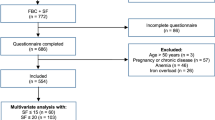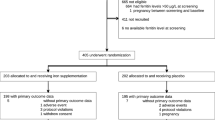Abstract
Objective: To examine the consequences of single iron depletion on health in menstruating women, a common but rarely investigated situation in industrialized countries.
Design: We studied data issued from the SU.VI.MAX. cohort via a transversal and a longitudinal (2-y follow-up) approach.
Subjects and methods: Iron-depleted menstruating women (ferritin <15 μg/l, n=472) were compared with iron-sufficient (ferritin 30–80 μg/l, n=393) menstruating women (aged 35–51 y) in terms of health variables and quality of life (DUKE score) using logistic regression and analysis of variance.
Results: The risk of any infection or of specific types of infections was not increased by iron deficiency. Regarding the DUKE health profile, no specific score was significantly different between the two groups: only the scores reflecting ‘physical health’ (P=0.09) and ‘perceived health’ (P=0.12) showed a trend toward a lower level, while the best score for ‘mental health’ (P=0.11) was found in the group of iron-depleted women. The only significant difference between iron-depleted and iron-sufficient women concerned memory disorders, which were significantly less common in iron-depleted women, Odds ratio=0.7 (0.6–0.9; P=0.03).
Conclusions: There is no conclusive evidence that an absence of iron stores has negative consequences; however, we must consider that in the case of a worsening of the iron balance, it may lead to a rapid decrease in the level of functional compounds.
Sponsorship: The laboratory Robapharm, Pierre Fabre, France.
This is a preview of subscription content, access via your institution
Access options
Subscribe to this journal
Receive 12 print issues and online access
$259.00 per year
only $21.58 per issue
Buy this article
- Purchase on Springer Link
- Instant access to full article PDF
Prices may be subject to local taxes which are calculated during checkout
Similar content being viewed by others
References
Al-Younes HM, Rudel T, Brinkmann V, Szczepek AJ & Meyer TF (2001): Low iron availability modulates the course of Chlamydia pneumoniae infection. Cell. Microbiol. 3, 427–437.
Bohbot VD, Allen JJ & Nadel L (2000): Memory deficits characterized by patterns of lesions to the hippocampus and parahippocampal cortex. Ann. N. Y. Acad. Sci. 911, 355–368.
Bouchet C, Guillemin F, Paul-Dauphin A & Briançon S (2000): Selection of quality-of-life measures for a prevention trial: a psychometric analysis. Control. Clin. Trials 21, 30–43.
Centers for Disease Control (CDC) (1998): Recommendations to prevent and control iron deficiency in the United States. MMWR 47, 1–25.
Collaborative Group on Hormonal Factors in Breast Cancer (1997): Breast cancer and hormone replacement therapy: collaborative reanalysis of data from 51 epidemiological studies of 52705 women with breast cancer and 108411 women without breast cancer. Lancet 390, 1047–1059.
Dallman PR (1987): Iron deficiency and the immune response. Am. J. Clin. Nutr. 46, 329–334.
Erikson KM, Jones BC, Hess EJ, Zhang Q & Beard JL (2001): Iron deficiency decreases dopamine D(1) and D(2) receptors in rat brain. Pharmacol. Biochem. Behav. 69, 409–418.
Fogelholm M, Alopaeus K, Silvennoinen T & Teirila J (1993): Factors affecting iron status in non-pregnant women from urban south Finland. Eur. J. Clin. Nutr. 47, 567–574.
Galan P, Yoon HC, Preziosi P, Viteri F, Valeix P, Fieux B, Briançon S, Malvy D, Roussel A-M, Favier A & Hercberg S (1998). Determining factors in the iron status of adult women in the SU.VI.MAX study. Eur. J. Clin. Nutr. 52, 383–388.
Guillemin F, Paul-Dauphin A, Virion JM, Bouchet C & Briançon S (1997): The DUKE health profile: a generic instrument to measure the quality of life tied to health. Santé Publ. 9, 35–44 (in French).
Haas JD & Brownlie IV T (2001): Iron deficiency and reduced work capacity: a critical review of the research to determine a causal relationship. J. Nutr. 131(Suppl 2), S676–S690.
Hallberg L (1995): Results of surveys to assess iron status in Europe. Nutr. Rev. 53, 314–322.
Hallberg L & Asp NG (1996): Iron Nutrition in Health and Disease, p 364. London: John Libbey.
Hallberg L, Hulthen L, Bengtsson C, Lapidus L & Lindstedt G (1995): Iron balance in menstruating women. Eur. J. Clin. Nutr. 49, 200–207.
Hallberg L, Hulthen L & Garby L (1998): Iron stores in man in relation to diet and iron requirements. Eur. J. Clin. Nutr. 52, 623–631.
Hallberg L, Hulthen L & Garby L (2000): Iron stores and haemoglobin iron deficits in menstruating women. Calculations based on variations in iron requirements and bioavailability of dietary iron. Eur. J. Clin. Nutr. 54, 650–657.
Hercberg S, Galan P & Dupin H (1990): Recent Knowledge on Iron and Folate Deficiency in the World, p 700. Paris: Editions INSERM.
Hercberg S, Preziosi P, Briançon S, Galan P, Triol I, Malvy D, Roussel A-M & Favier A (1998): A primary prevention trial of nutritional doses of antioxidant vitamins and minerals on cardiovascular diseases and cancers in general population: The SU.VI.MAX study. Design, methods and participants characteristics. Control. Clin. Trials 19, 336–351.
Hercberg S, Preziosi P, Galan P, Faure H, Arnaud J, Duport N, Malvy D, Roussel A-M, Briançon S & Favier A (1999): ‘The SU.VI.MAX study’: a primary prevention trial using nutritional doses of antioxidant vitamins and minerals in cardiovascular diseases and cancers. Food Chem. Toxicol. 37, 925–930.
Hercberg S, Preziosi P & Galan P (2001): Iron deficiency in Europe. Public Health Nutr. 4, 537–545.
Hulthen L, Lindstedt G, Lundberg PA & Hallberg L (1998): Effect of a mild infection on serum ferritin concentration—clinical and epidemiological implications. Eur. J. Clin. Nutr. 52, 376–379.
Parkerson Jr GR, Broadhead WE & Tse CK (1991): Development of the 17-item Duke Health Profile. Fam. Pract. 8, 396–401.
Prasad AN & Prasad C (1991): Iron deficiency; non-hematological manifestations. Prog. Food Nutr. Sci. 15, 255–283.
Sato S (1991): Iron deficiency: structural and microchemical changes in hair, nails, and skin. Semin. Dermatol. 10, 313–319.
UNICEF/WHO/UNU/MI (1998): Preventing Iron Deficiency in Women and Children: Technical Consensus on Key Issues and Resources for Programme Advocacy, Planning, and Implementation. New York: UNICEF.
Walter T, Olivares M, Pizarro F & Munoz C (1997): Iron, anemia, and infection. Nutr. Rev. 55, 111–124.
Youdim MB, Ben-Shachar D, Ashkenazi R & Yehuda S (1983): Brain iron and dopamine receptor function. Adv. Biochem. Psychopharmacol. 37, 309–321.
Youdim MB, Ben-Shachar D & Yehuda S . (1989): Putative biological mechanisms of the effect of iron deficiency on brain biochemistry and behavior. Am. J. Clin. Nutr. 50, S607–S617.
Youdim MB & Yehuda S (2000): The neurochemical basis of cognitive deficits induced by brain iron deficiency: involvement of dopamine–opiate system. Cell. Mol. Biol. (Noisy-le-grand) 46, 491–500.
Zhu YI & Haas JD (1997): Iron depletion without anemia and physical performance in young women. Am. J. Clin. Nutr. 66, 334–341.
Author information
Authors and Affiliations
Contributions
Guarantor: S Hercberg.
Contributors: ND did the data statistical analysis and was primarily responsible for writing the manuscript. PP, M-CBR, SB and PG contributed ideas for analysis and editing the paper. AF and JLL carried out ferritin and hemoglobin analyses. SH supervised the whole process.
Corresponding author
Rights and permissions
About this article
Cite this article
Duport, N., Preziosi, P., Boutron-Ruault, MC. et al. Consequences of iron depletion on health in menstruating women. Eur J Clin Nutr 57, 1169–1175 (2003). https://doi.org/10.1038/sj.ejcn.1601669
Received:
Revised:
Accepted:
Published:
Issue Date:
DOI: https://doi.org/10.1038/sj.ejcn.1601669



